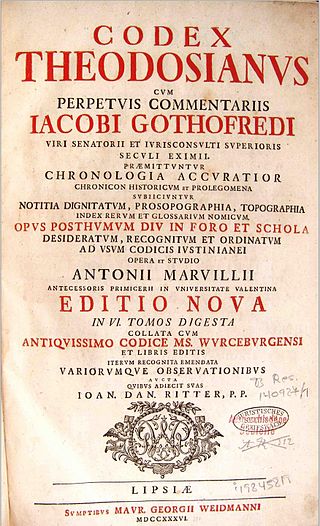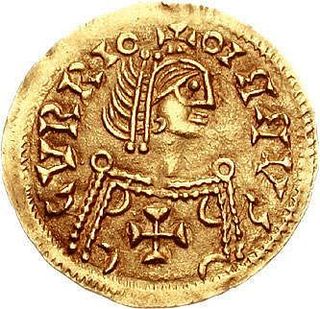
Alaric II was the King of the Visigoths from 484 until 507. He succeeded his father Euric as king of the Visigoths in Toulouse on 28 December 484; he was the great-grandson of the more famous Alaric I, who sacked Rome in 410. He established his capital at Aire-sur-l'Adour in Aquitaine. His dominions included not only the majority of Hispania but also Gallia Aquitania and the greater part of an as-yet undivided Gallia Narbonensis.

The Visigoths were a Germanic people united under the rule of a king and living within the Roman Empire during late antiquity. The Visigoths first appeared in the Balkans, as a Roman-allied barbarian military group united under the command of Alaric I. Their exact origins are believed to have been diverse but they probably included many descendants of the Thervingi who had moved into the Roman Empire beginning in 376 and had played a major role in defeating the Romans at the Battle of Adrianople in 378. Relations between the Romans and Alaric's Visigoths varied, with the two groups making treaties when convenient, and warring with one another when not. Under Alaric, the Visigoths invaded Italy and sacked Rome in August 410.
The 500s decade ran from January 1, 500, to December 31, 509.
Year 506 (DVI) was a common year starting on Sunday of the Julian calendar. At the time, it was known as the Year of the Consulship of Messala and Dagalaiphus. The denomination 506 for this year has been used since the early medieval period, when the Anno Domini calendar era became the prevalent method in Europe for naming years.

The Corpus JurisCivilis is the modern name for a collection of fundamental works in jurisprudence, issued from 529 to 534 by order of Byzantine Emperor Justinian I. It is also sometimes referred to metonymically after one of its parts, the Code of Justinian.

The Visigothic Code, also called Lex Visigothorum, is a set of laws first promulgated by king Chindasuinth of the Visigothic Kingdom in his second year of rule (642–643) that survives only in fragments. In 654 his son, king Recceswinth (649–672), published the enlarged law code, which was the first law code that applied equally to the conquering Goths and the general population, of which the majority had Roman roots, and had lived under Roman laws.

The Digest, also known as the Pandects, was a compendium or digest of juristic writings on Roman law compiled by order of the Byzantine emperor Justinian I in 530–533 AD. It is divided into 50 books.

The Codex Theodosianus was a compilation of the laws of the Roman Empire under the Christian emperors since 312. A commission was established by Emperor Theodosius II and his co-emperor Valentinian III on 26 March 429 and the compilation was published by a constitution of 15 February 438. It went into force in the eastern and western parts of the empire on 1 January 439. The original text of the codex is also found in the Breviary of Alaric, promulgated on 2 February 506.

The Codex Euricianus or Code of Euric was a collection of laws governing the Visigoths compiled at the order of Euric, King of the Visigoths, sometime before 480, probably at Toulouse ; it is one of the earliest examples of early Germanic law. The compilation itself was the work of Leo, a Roman lawyer and principal counsellor of the king. The customs of the Visigothic nation were recognised and affirmed. The Code is largely confused and it appears that it was merely a recollection of Gothic custom altered by Roman law.
Brachylogus, is a title applied in the middle of the 16th century to a work containing a systematic exposition of the Roman law. Some writers have assigned to the reign of the emperor Justinian I, and others have treated as an apocryphal work of the 16th century.

The Edictum Rothari was the first written compilation of Lombard law, codified and promulgated on 22 November 643 by King Rothari in Pavia by a gairethinx, an assembly of the army. According to Paul the Deacon, the 8th century Lombard historian, the custom law of the Lombards had been held in memory before this. The Edict, recorded in Vulgar Latin, comprised primarily the Germanic custom law of the Lombards, with some modifications to limit the power of feudal rulers and strengthen the authority of the king. Although the edict has been drafted in Latin, a few Lombard words were left untranslated, such as "grabworfin, arga, sculdhais, morgingab, metfio, federfio, mahrworfin, launegild, thinx, waregang, gastald, mundius, angargathung, fara, walupaus, gairethinx, aldius, actugild or, wegworin".
The Law of Citations was a Roman law issued from Ravenna in AD 426 by the emperor Valentinian III, or rather by his regent mother, Galla Placidia Augusta, to the Senate and the people of Rome, and it was included in both Theodosius II's law compilation of 438 and the first edition of the Codex Justinianus.
Referendary is the English form of a number of administrative positions, of various rank, in chanceries and other official organizations in Europe.
Julius Paulus, often simply referred to as Paul in English, was one of the most influential and distinguished Roman jurists. He was also a praetorian prefect under the Roman Emperor Alexander Severus.
The Codex Gregorianus is the title of a collection of constitutions of Roman emperors over a century and a half from the 130s to 290s AD. It is believed to have been produced around 291–294 but the exact date is unknown.
The Codex Hermogenianus is the title of a collection of constitutions of the Roman emperors of the first tetrarchy, mostly from the years 293–94. Most of the work is now lost. The work became a standard reference in late antiquity, until it was superseded by the Breviary of Alaric and the Codex Justinianeus.

The Visigothic Kingdom, Visigothic Spain or Kingdom of the Goths occupied what is now southwestern France and the Iberian Peninsula from the 5th to the 8th centuries. One of the Germanic successor states to the Western Roman Empire, it was originally created by the settlement of the Visigoths under King Wallia in the province of Gallia Aquitania in southwest Gaul by the Roman government and then extended by conquest over all of Hispania. The Kingdom maintained independence from the Eastern Roman or Byzantine Empire, whose attempts to re-establish Roman authority in Hispania were only partially successful and short-lived.

Germanic law is a scholarly term used to describe a series of commonalities between the various law codes of the early Germanic peoples. These were compared with statements in Tacitus and Caesar as well as with high and late medieval law codes from Germany and Scandinavia. Until the 1950s, these commonalities were held to be the result of a distinct Germanic legal culture. Scholarship since then has questioned this premise and argued that many "Germanic" features instead derive from provincial Roman law. Although most scholars no longer hold that Germanic law was a distinct legal system, some still argue for the retention of the term and for the potential that some aspects of the Leges in particular derive from a Germanic culture.
Anianus was a Gallo-Roman nobleman who served as the referendary of Alaric II, king of the Visigoths. He was a vir spectabilis, that is, an "admirable man", or holder of high office in the empire.

The Lex Romana Curiensis, also known as the Lex Romana Raetica, Lex Romana Utinensis or Epitome Sancti Galli, is a Latin legal treatise of the eighth century from the region of Churraetia. It was not a law code in force, but a handbook for use in legal education. Nonetheless, it may be the basis of the Raetian lex et consuetudo that Charlemagne confirmed in the early 770s.












